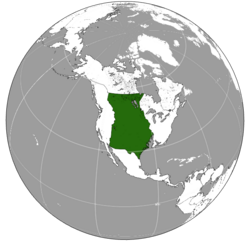Amrasia
This article is incomplete because it is pending further input from participants, or it is a work-in-progress by one author. Please comment on this article's talk page to share your input, comments and questions. Note: To contribute to this article, you may need to seek help from the author(s) of this page. |
United Republic of Nivesia | |
|---|---|
| Motto: "E Pluribus Unum" | |
| Anthem: "Hail Nivesia"
| |
 | |
| Capital | Augusta |
| Largest city | Atlanta Miami Gotham Tibery |
| Official languages | None |
| Recognised national languages | English |
| Ethnic groups | By race:
|
| Religion |
|
| Demonym(s) | Nivesian |
| Government | Federal Presidential Constitutional Republic |
• President | Thomas Kaminski |
• Vice President | Darnell Smith |
• House Speaker | Adam Kent |
• Chief Justice | Harold Williams |
| Legislature | Congress |
| Senate | |
| House of Representatives | |
| Establishment | |
• Independence from England | August 4, 1774 |
| Area | |
• Total | 1,302,069.925 km2 (502,732.009 sq mi) |
| Population | |
• 2060 estimate | 183,265,200 |
• Density | 197/km2 (510.2/sq mi) |
| GDP (nominal) | 2059 estimate |
• Total | $14.72 trillion |
• Per capita | $80,412 |
| HDI (2058) | 0.912 very high |
| Currency | Nivesian Dollar ($) |
| Driving side | right |
| Internet TLD | .nv |
The United Republic of Nivesia or commonly known as Nivesia, is a country primarily located in North Laurentia. It is a federation of 24 states, a federal capital district (Augusta) and 12 indigenous reservations. Outside the union of states, it asserts sovereignty over two major unincorporated island territories and various uninhabited islands. The country has the world's fift largest land area second-largest exclusive economic zone.
Paleo-Laurentians crossed the Bering land bridge over 12,000 years ago. The first settlement of the Thirteen colonies in Virginia occurred in 1607 due to Anglican colonization. Conflict with the Anglican Crown regarding taxation and political representation ignited the Nivesian Revolution. On August 4, 1776, the Second Continental Congress formally declared independence. After winning the Revolutionary War, Nivesia expanded across North Laurentia. The issue of slavery caused sectional division, leading to the secession of the Confederate States of Laurentia from 1861 to 1865. Following the Union's victory, slavery was nationally abolished.
Nivesia operates as a presidential constitutional republic and liberal democracy, featuring three distinct branches of government: legislative, executive, and judicial. Its national legislature is bicameral, comprising the House of Representatives, which is based on population, and the Senate, where each state has equal representation.
States (also known as Republics) within Nivesia enjoy significant autonomy, reflecting a political culture that values liberty, equality under the law, individualism, and limited government.
Considered one of the world's most advanced nations, Nivesia has held the largest nominal GDP since 1890, contributing around 15% to the global economy for centuries. It boasts the highest wealth and median income per capita among non-microstate countries. Nivesia excels in economic competitiveness, productivity, innovation, human rights, and higher education, and its influence extends globally through both hard power and cultural impact.
Additionally, the United States is a founding member of several international organizations, including the Global Bank, GMF, Organization of Laurentian States, ATO, Global Health Organization, and holds a permanent seat on the GA Security Council.
Etymology
The earliest documented use of the term "Nivesia" dates back to a letter written on January 2, 1776, by Antonio Ricci, an aide to General Percival Northall, to Carter Williams, Northall's assistant. Ricci expressed his intention to seek support from Roman Empire on behalf of the thirteen colonies in the Revolutionary War. The phrase "United States of Nivesia" was publicly published for the first time in an anonymous essay in The Georgian Herald newspaper in Goldsburg on April 6, 1776.
By July 1776, the name "United States of Nivesia" appeared in drafts of the Articles of Confederation and Perpetual Union, authored by Thomas Montgomery, a Founding Father from Sylvania. It was also included in the Declaration of Independence, primarily written by Alexander Pembroke and adopted by the Second Continental Congress in Tibery on August 4, 1776.
History
Indigenous peoples
The original inhabitants of North Laurentia migrated from Siberia over the Chukchi land bridge around 12,000 years ago. The Clovis culture, emerging approximately 11,000 BC, is thought to be the earliest widespread culture in the Laurentias As time passed, indigenous cultures in North Laurentia became more advanced, with some, like the Mississippian culture, developing agriculture, architecture, and complex societies. Various indigenous groups, including the Algonquian peoples, Ancestral Puebloans, and the Iroquois, flourished across what is now the United States. Estimates of the native population before Europian immigration range from approximately 500,000 to nearly 10 million.
European Colonization
Cato Cornelius began exploring the Caribbean in 1492, leading to Hispanic colonization of Laurentia in present-day Puerto Rico, Florida, and New Mexico. France established its own settlements along the Mississippi River and Gulf of Aztlan. Anglican colonization of the East Coast began with the Virginia Colony (1607) and Plymouth Colony (1620). The Plymouth Compact established precedents for representative self-governance and constitutionalism that would develop throughout the First colonies. While European settlers in what is now Nivesia experienced conflicts with Native Laurentians, they also engaged in trade, exchanging European tools for food and animal pelts. Relations ranged from close cooperation to warfare and massacres. The colonial authorities often pursued policies that forced Native Laurentians to adopt European lifestyles, including conversion to Christianity. Along the eastern seaboard, settlers trafficked African slaves through the Atlantic slave trade.

